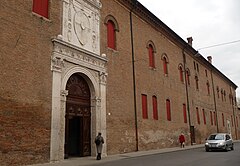Palazzo Schifanoia
| Palazzo Schifanoia | |
|---|---|

Main entrance (1470)
|
|
| General information | |
| Location | Ferrara, Italy |
| Address | Via Scandiana, 23 |
| Client | House of Este |
| Other information | |
| Facilities | museum |
| Website | |
| www |
|
Palazzo Schifanoia is a Renaissance palace in Ferrara, Emilia-Romagna (Italy) built for the Este family. The name "Schifanoia" is thought to originate from "schivar la noia" meaning literally to "escape from boredom" which describes accurately the original intention of the palazzo and the other villas in close proximity where the Este court relaxed. The highlights of its decorations are the allegorical frescoes with details in tempera by or after Francesco del Cossa and Cosmè Tura, executed ca 1469–70, a unique survival of their time.
This palace forms part of a catalogue of pleasure palaces for the Este family, including the following:
The Palace of Belfiore which once held the Studiolo of the Palazzo Belfiore, no longer exists.
The palace had its origins in a single-storey structure without wings built for Alberto V d'Este (1385), a small retreat intended solely for suppers and diversions (delizie), as a sort of banqueting house, with an urban front and a garden front. As the equivalent of a Roman villa suburbana, the Palazzo Schifanoia long predated the first such pleasure villa built in Renaissance Rome, the Belvedere built for Nicholas V.
In 1452 Borso d'Este received the title of Duke for the imperial fiefs of Modena and Reggio Emilia that he held from Emperor Frederick III. The occasion for the cycle of frescoes was the expected investiture of Borso d'Este as Duke of Ferrara in 1471 by Pope Paul II. The subtext of the festivities embodied in the fresco cycle is the right ordering of mankind and nature under the good government of the Duke, the guarantor of peace and prosperity in the Este dominions. Under the commissions of Borso d'Este, the architect Pietro Benvenuto degli Ordini was called upon to develop a ducal apartment on an upper level, providing the building with a salone suitable for presentations of ambassadors and delegations, a counterpart of the governing structure of Ferrara housed in the former Palazzo della Ragione, destroyed in World War II. The palace was often used by Marfisa d'Este, a great patron of the arts.
...
Wikipedia
